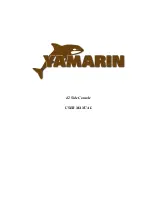
W
I N T E R I Z A T I O N
A N D
S
T O R A G E
7–2
For outdoor storage, a canvas cover should be used to prevent “sweating”. One method is to
build a frame over the boat to support the canvas. It should be a few inches wider than the boat so
the canvas will clear the rails and allow passage of air. The cover should be fastened securely so
that winds cannot remove it or cause it to chafe the boat. A poor covering job will eventually cost
more than the price of a well-made cover.
C
LEANING
A
ND
L
UBRICATING
T
HE
B
OAT
Clean and wax your boat before storage. If you store your boat in the water, there may be a
layer of growth on the bottom. As it dries, this debris will harden. Clean, scrub and scrape the
bottom promptly when the boat is removed from the water. Remove all marine growth and other
foreign matter from the hull. Clean the inside of hull openings, thru-hull fittings and scupper
drains. Inspect the hull for damage. Remember to avoid harsh cleaners, citrus solutions and
bleaches; these could have harmful effects on your boat’s gel-coat and metal components.
Check cleats and rails for corrosion and tightness. Clean stainless steel as directed under
“Hardware/Hardtop Frame/Stainless Steel Rails” on page 6–5
. Use a quality metal preservative
like T-9™ on metal surfaces to prevent salt-water damage. Check for loose silicone, hinges and
unseated gaskets. Replace or tighten where necessary. Heavy seas pounding and twisting the hull
can cause leaks in your windows, doors and hatches. Check hinges for corrosion. Lubricate hinges
as necessary.
The T-9™
metal protection product was developed by Boeing™ Aviation for long-term protection of aircraft. It works
by coating and penetrating fasteners and fixtures, displacing moisture and drying to a clear wax film that lubricates
and protects metals for months. T-9 can be used to protect deck hardware, engines, electronics, and fishing tackle.
D
RAINING
& W
ATER
S
YSTEM
If the boat is stored out of water, remove the garboard drain plug to keep the bilge dry. Store
your boat with the bow elevated for drainage.
Drain all water tanks, hoses, filters and pumps to prevent freeze damage. The fresh water
system may be drained by running any faucet until the tank is empty. When empty, turn the water
pump off to prevent damage. Remove the filter on the freshwater pump inlet, remove any water
and reinstall. Residual water will not damage the tank. The water heater must be drained
individually after emptying the water tank. Drain the water heater by opening the drain faucet on
the water heater. The water from the water heater will drain into the bilge. If desired, the fresh
water system may have a non-toxic antifreeze for potable water systems added. To drain other
systems, close seacocks and run the pumps until the lines are dry. Open the seacocks after lines
are dry. Draining will help prevent water stagnation in warmer climates.
W A R N I N G
Boats covered with plastic shrink wrap during storage must leave the fuel fill and vent fitting
outside of the enclosure to prevent the trapping of dangerous fumes or spillage from thermal
expansion.
!
Summary of Contents for Tournament 307
Page 8: ...W E L C O M E 1 4 ...
Page 28: ...P E R F O R M A N C E 4 6 ...
Page 34: ...I N S T R U M E N T A T I O N A N D S W I T C H E S 5 6 ...
Page 46: ...M A I N T E N A N C E A N D S E R V I C E 6 12 ...
Page 52: ...W I N T E R I Z A T I O N A N D S T O R A G E 7 6 ...
Page 80: ...3 0 7 T O U R N A M E N T 8 28 A C I n v e r t e r S c h e m a t i c ...
















































